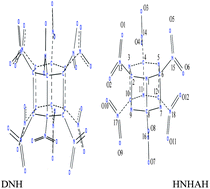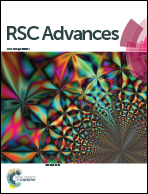Computer-aided design of two novel and super-high energy cage explosives: dodecanitrohexaprismane and hexanitrohexaazaprismane†
Abstract
We report new strategies to design two novel and super-high energy cage explosives: dodecanitrohexaprismane (DNH) and hexanitrohexaazaprismane (HNHAH). First, the energetic properties and stability of DNH were estimated by using density functional theory. Second, the six carbon atoms of hexaprismane are replaced by using six nitrogen atoms symmetrically to form 1,3,5,7,9,11-hexaazahexaprismane and then all six hydrogen atoms of 1,3,5,7,9,11-hexaazahexaprismane are substituted by nitro groups to form HNHAH. Next, its performance was evaluated and compared with those of DNH and octanitrocubane (ONC). Finally, the molecular mechanics method was used to predict their molecular packing. The results indicate that DNH has much higher energetic properties than ONC, which may be the most powerful nonnuclear explosive known so far. DNH is more sensitive than ONC but has comparative sensitivity with RDX (1,3,5-trinitro-1,3,5-triazinane) and HMX (1,3,5,7-tetranitro-1,3,5,7-tetrazocane). Although HNHAH has lower energetic properties than DNH, it has higher energetic properties than ONC slightly. HNHAH is much more insensitive than DNH and is slightly less sensitive than ONC.


 Please wait while we load your content...
Please wait while we load your content...